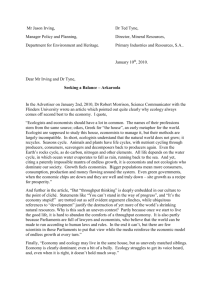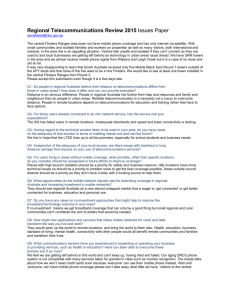Response to the interim report:
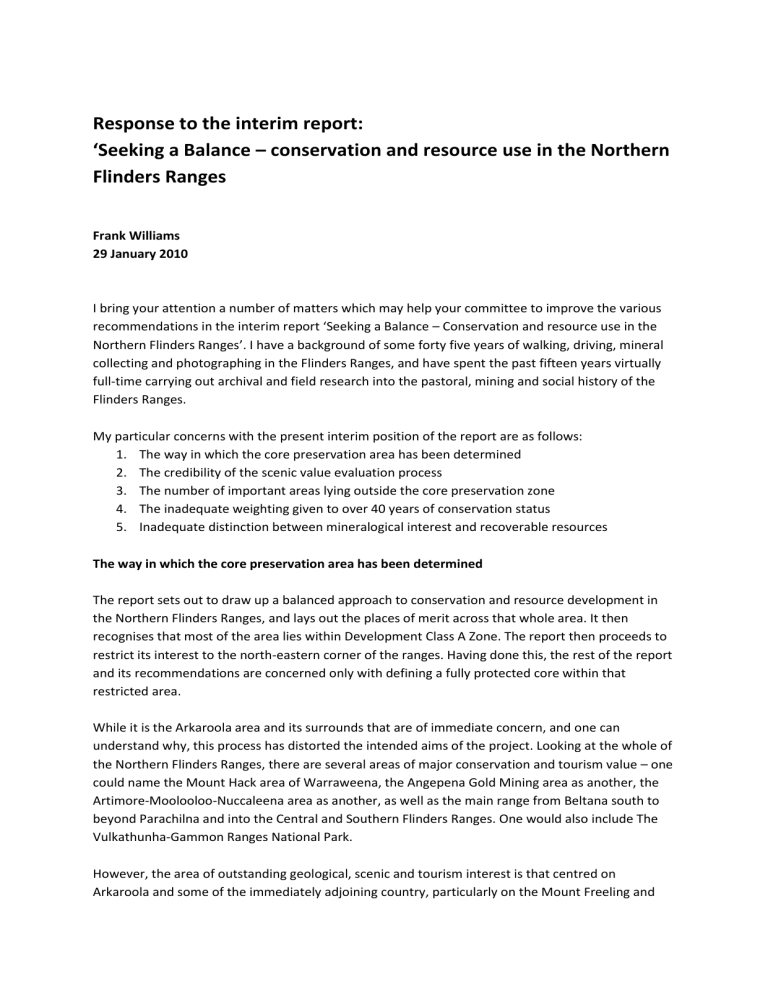
Response to the interim report:
‘Seeking a Balance – conservation and resource use in the Northern
Flinders Ranges
Frank Williams
29 January 2010
I bring your attention a number of matters which may help your committee to improve the various recommendations in the interim report ‘Seeking a Balance – Conservation and resource use in the
Northern Flinders Ranges’. I have a background of some forty five years of walking, driving, mineral collecting and photographing in the Flinders Ranges, and have spent the past fifteen years virtually full-time carrying out archival and field research into the pastoral, mining and social history of the
Flinders Ranges.
My particular concerns with the present interim position of the report are as follows:
1.
The way in which the core preservation area has been determined
2.
The credibility of the scenic value evaluation process
3.
The number of important areas lying outside the core preservation zone
4.
The inadequate weighting given to over 40 years of conservation status
5.
Inadequate distinction between mineralogical interest and recoverable resources
The way in which the core preservation area has been determined
The report sets out to draw up a balanced approach to conservation and resource development in the Northern Flinders Ranges, and lays out the places of merit across that whole area. It then recognises that most of the area lies within Development Class A Zone. The report then proceeds to restrict its interest to the north-eastern corner of the ranges. Having done this, the rest of the report and its recommendations are concerned only with defining a fully protected core within that restricted area.
While it is the Arkaroola area and its surrounds that are of immediate concern, and one can understand why, this process has distorted the intended aims of the project. Looking at the whole of the Northern Flinders Ranges, there are several areas of major conservation and tourism value – one could name the Mount Hack area of Warraweena, the Angepena Gold Mining area as another, the
Artimore-Moolooloo-Nuccaleena area as another, as well as the main range from Beltana south to beyond Parachilna and into the Central and Southern Flinders Ranges. One would also include The
Vulkathunha-Gammon Ranges National Park.
However, the area of outstanding geological, scenic and tourism interest is that centred on
Arkaroola and some of the immediately adjoining country, particularly on the Mount Freeling and
Yudnamutana side. There are good historical reasons why the Arkaroola country and its boundaries constitute such an important area of scenic and tourist interest. This was the country ‘fenced out’ of the surrounding properties (Balcanoona, Wooltana, Mount Freeling in particular) in the early years of the twentieth century. It had become infested with wild dogs, and the only way to contain the problem was to put vermin-proof fences around those mountainous and inaccessible places where the dogs could not be controlled. These fences were built as close as possible to the ranges so as to retain as much accessible pastoral land as could be achieved. These ‘fenced out’ areas remained part of the original leases, and still subject to pastoral rents, but were no longer able to be stocked.
In the mid-1930s Gordon Greenwood, of Mount Serle Station, purchased from Wooltana, Mount
Freeling, Balcanoona and others their interests in the fenced-out sections of their leases. These contiguous blocks came to be known as Arkaroola.
This historical background explains why Arkaroola became a lease with such astounding scenic and scientific interest – it was a ‘naturally-selected’ wilderness area. This was, of course, in combination with (and as a result of) the particular geological origins of the country – the granite intrusions, the extreme metamorphism of its overlying sedimentary rock systems, the distinctive upside-downpudding-basin formations of its weathered granitic terrains.
The upshot of this is that Arkaroola is of extremely high conservation merit from boundary to boundary. Its boundary with the National Park is the boundary of the unaltered folded sediments to the south and the highly altered sediments and then granites to the north. Its boundary with
Umberatana and Mount Freeling on the western side is similarly the change from unaltered sediments to the highly-altered rocks of the Wheal Turner - Yudnamutana – Daly Mine country. The northern country, almost to the Moolawatana Homestead, is the quite stunning escarpment country largely associated with the Paralana Fault.
The report implies that the Gammon Plateau and surrounding National Park adequately conserves the high country plant and animal species. Firstly, this ignores the importance of conserving a wide distribution area for species – even in very favourable ecosystems. Secondly, it ignores the fact that most of Arkaroola’s plant species are based on soils deriving from granitic or highly metamorphosed rocks, and the micro-ecosystems of a granitic terrain can be quite different to those of the sandstone terrains of Vulkathunha – Gammon Ranges.
The credibility of the scenic evaluation process
As one who was invited to take part in the questionnaire process re the scenic qualities of the region,
I can only make the suggestion to your committee that this part of the study was most inadequate.
The feeling as one proceeded to answer the questions was that this was a poorly constructed exercise, using woefully inadequate photographs. Once the committee viewed the responses and the invited comments of the participants it should have ruled that part of the survey out of consideration.
A quick look through the participants’ final comments on the survey is most enlightening. Many completely misinterpreted what the survey was asking – many to such an extent that their responses
should have been discounted. A number commented that they liked the beach scenes best, or they didn’t like dry country at all. A large number commented (quite correctly) that the photographs were of very widely varying quality – both in composition and in technical merit; some were out of focus, some were completely out of context; some were woefully composed or cropped.
As one who has photographed all parts of the Flinders Ranges for forty five years, I can confidently state that the thing which stands out about the Arkaroola country is that it is so bold and confronting that it is extremely difficult to photograph. It is quite unlike the snap-a-minute postcard quality of the central Flinders Ranges around Arakaba and Wilpena. This difficult-to-photograph aspect of the
Arakaroola country was manifestly demonstrated in this scenic survey.
The Arkaroola country is one of the world’s staggeringly beautiful places. It is up with the best anywhere – quite different from many of the world’s great places, but clearly up with them. It is this
‘difference’ which makes it so important to conserve.
The number of important places lying outside the core preservation zone
The only part of Arkaroola receiving full protection under this interim proposal is a central section of the Freeling Heights – Mawson Plateau area. This suggests that the committee viewed total protection as being merited by true wilderness country. This fails to understand that virtually all of
Arakaroola has remained wilderness country from ancient times right up until 2010. The rough and inaccessible nature of the country prevented any settlement within this section of the ranges until the late 1930s, and even that pastoral venture only lasted, at the outside, from 1936 until 1968. For those thirty years, stock didn’t penetrate in numbers much beyond the foothill country, the
Balcanoona boundary and the valleys near the homestead. To use the words of the lessee of the
Bryce Canyon country, it was ‘A helluva place to lose a cow’. It was sheep at Arkaroola, but the same message applies.
While arguing that the whole of Arkaroola merits total protection, I would add that some particularly important factors have been missed in the current interim proposal.
The lengthy series of pegmatite dykes along Mawson Valley and right out westwards to the
Pinnacles and even Tourmaline Hill on Umberatana are iconic in themselves. It is inconceivable that anything less than total protection should apply to this section of country.
The Balcanoona Wattle (listed as spidery wattle), Acacia araneosa, has a very restricted global distribution – barely any wider a distribution than the Wollemi Pine. The core areas are on Arkaroola, with little more that outlier occurrences on the National Park, and none elsewhere. The core area for this species is along the boundary with the National Park, on the Arkaroola side. Yet this particular section of country has no protection.
The areas of Arkaroola most visited by tourists in their own cars are not in the fully protected zone – they can have low level exploration, and mining operations can be considered on their merits. For one of Australia’s very significant outback tourism destinations, this is far from an adequate level of protection.
The Yudnamutana area is of great historical interest with the ruins of its mining enterprises from the
1860s through to early 1900s. As with virtually all mining in the Flinders Ranges, these were either short-lived operations or little more than ‘prospects’, but they make for an interesting history. This area has limited protection.
Stubbs Waterhole protects a small portion of the very impressive tillite beds, but the section of gorge from there out to the eastern plains – arguably the most staggering examples of tillite beds – lacks protection. It would appear to be very short-sighted to protect merely a ‘window’ onto that glacial history when the enormity of glacial periods and glacial activity is best understood from seeing the great extent of the glacial beds.
Many of the sites known for many years as mineral specimen sites have limited or no protection.
These are what have made Arkaroola unique – a wonderland of mineral sites and mineralogical history. The history of mining itself, by contrast, is one of failure and disappointment – a result of the extremely convulsive geological processes that have made the Arkaroola a country so unique – yet have made its recoverable resources so minor and uneconomic. The successful mining ventures have been those out on the plains where the strata have not been so convulsed or where the ancient
Precambrian beds have been left unaltered for a billion years or more (in the manner of Moonta –
Kadina- Wallaroo, or Broken Hill, Iron Knob, Roxby Downs).
The country extending northwards almost to Moolawatana is virtual-wilderness country that merits total protection. Again, the mining ventures at Parabarana and the like were small shows, and the impact of mining there was quite limited. As the northernmost extension of the Range and the
Paralana Fault system, this merits protection from mining ventures.,
The inadequate weighting given to over 40 years of conservation status
The Arkaroola Sanctuary is effectively the longest-running conservation area in the Flinders Ranges, particularly as one devoted to introducing travellers to the geological, botanical and scenic wonders of Australia. It has operated as a professionally managed conservation park for forty two years. The conservation and educational aspect of the operation has been at the forefront since 1968.
Deliberately limited track access was put in place at the beginning so that the wilderness quality would be preserved for evermore. It now appears that that strategically-placed trackwork has led to large sections being seen from Adelaide as somehow reduced in their wilderness quality.
The Arkaroola Sanctuary pre-dates any of the national parks in the central and northern ranges. In
1968, there were local scenic spots at Mambray Creek and the gorges outside Quorn, and a ‘national pleasure resort’ within the bowl of Wilpena Pound itself. There has been a privately-run motel and camping resort at the entrance to Wilpena Pound since the 1940s, but the only reserved area was within the Pound and the outlet gorge. The Oraparinna National Park came into being in the following decade, as did the Gammon Ranges National Park, and it wasn’t until the mid-1980s that the Flinders Ranges National Park came about. The 1990s saw another private park at Warraweena.
Even when the Flinders Ranges and Vulkathunha – Gammon Ranges National Parks were dedicated, they only preserved some of the scenic sandstone-ranges country – certainly quite beautiful and well-worth the highest level of preservation. But Arkaroola preserved amazing wilderness country, granite and metamorphosed country which is spectacularly different, and geological sites of absolute world class. It preserved country that was virtually untouched despite its prospecting history a century ago. It was too rugged to get into, for man or beast. And what goats got into the country in the 1950s and 1960s were systematically culled over the next decade by the family operating the sanctuary. Arkaroola has a uniqueness which puts it in a class of its own in Australia – and which ranks it alongside the world’s best parks.
So Arkaroola was essentially the first conservation park of any extent. It was developed and managed by a family dedicated to preserving the wonderful wilderness of the Arkaroola country, and dedicated to displaying the geological wonders of Arkaroola to the world – both the scientific world and the travelling public. Against considerable odds, both natural and man-made, the Sprigg family have remained true to Reg and Griselda Sprigg’s dream. They have weathered droughts, floods, fuel shortages, questionable road closures, and have sunk the value of their pre-existing business ventures into this enterprise. Without being over-dramatic, it is self-evident to anyone who has respect for this country that South Australia owes it to this family to provide the whole of
Arkaroola with the highest level of protection.
Inadequate distinction between mineralogical interest and recoverable resources
The past 160 years of history in the Flinders Ranges has shown that mineral deposits within the ranges themselves are rarely more than of mineralogical or geological interest. Leigh Creek’s coal deposits (more on the plains than within the ranges) have certainly been economically viable, and some families have made a living of sorts from barite deposits, but other ventures have been either small operations or little more than two-man operations relying on government rations in times of recession. Nevertheless, even trial-pits show on the geology maps as mines, giving the general public a misleading impression of the real mining potential.
Most modern drilling has suggested the same thing about the nature of mineral deposits within the ranges – isolated small bunches of rich ore, widespread mineral ‘staining’ rather than mineral seams, very fragmented distribution, and all located at great distance from ports along rough outback roads.
Perhaps the only real exception in the past hundred years has been the Ajax Mine at Puttapa – but again a short-lived if modestly productive deposit.
The risk of allowing mineral exploration, with the opportunity of mining operations ‘on a case-bycase basis’, is that short-term rises in the prices for some metal or other will lead to degradation of particular districts or valleys or gorges, or even certain ridgetops, for short-term gain. And this is even more unsupportable when massive deposits exist in other, less critical, areas – but are owned by other companies. This type of risk is well exemplified by the case of the magnesite deposits in the
Gammon Ranges, where it took a rather brave political move by a State Minister to quash the development. Such brave moves are relatively risky events to rely on - the cost to the incumbent minister is usually far too high.
Conclusion
The report in its interim form appears to misunderstand the uniqueness and quality of the whole of the Arkaroola country. The whole of Arkaroola is by its nature and its historical background a wilderness or near-wilderness, and its recent history has made it an outstanding example of what can be done to protect such a unique environment.
There is a tendency in Australia to under-rate our natural attractions. As one who has visited many of the world’s great parks and iconic places, I have no hesitation in stating that Arkaroola as a natural wonderland is up with the best in the world – whether in scale, or uniqueness, or staggering beauty, or scientific wonder.
Arkaroola has effectively operated as one of Australia’s most iconic national parks without having the title of one. The conservation ethic of the sanctuary’s founders was spelt out fully in 1868 and has been adhered to ever since. Arkaroola Sanctuary has achieved, and is continuing to achieve, a level of environmental protection that governments have found increasingly difficult to achieve and maintain in publicly-owned properties. The Sprigg family have essentially achieved this at their own private and personal expense. While such an argument may appear inappropriate in the context of developing a resource utilisation strategy for the region, it must be seen in the context of Reg and
Griselda Sprigg’s recognition forty two years ago of the uniqueness of Arkaroola in a world-wide sense, and the overwhelming need to preserve it for prosperity.
This dream – for the entire Arkaroola property - should be shared by all Australians.
Frank Williams
(personal contact details deleted)
29 January 2010
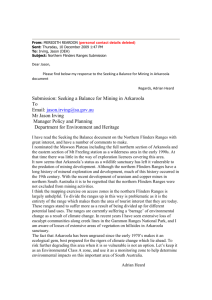
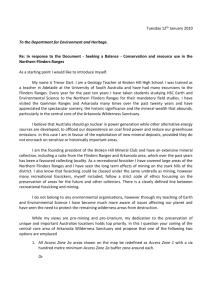


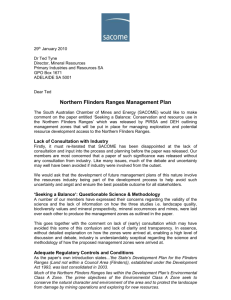
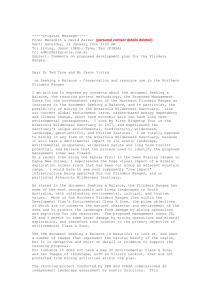
![From: Tim Baier [(personal contact details deleted)] Sent: Friday, 29](http://s3.studylib.net/store/data/007456569_1-cd6b9d27cd845dba556bb66ac2b529ac-300x300.png)
